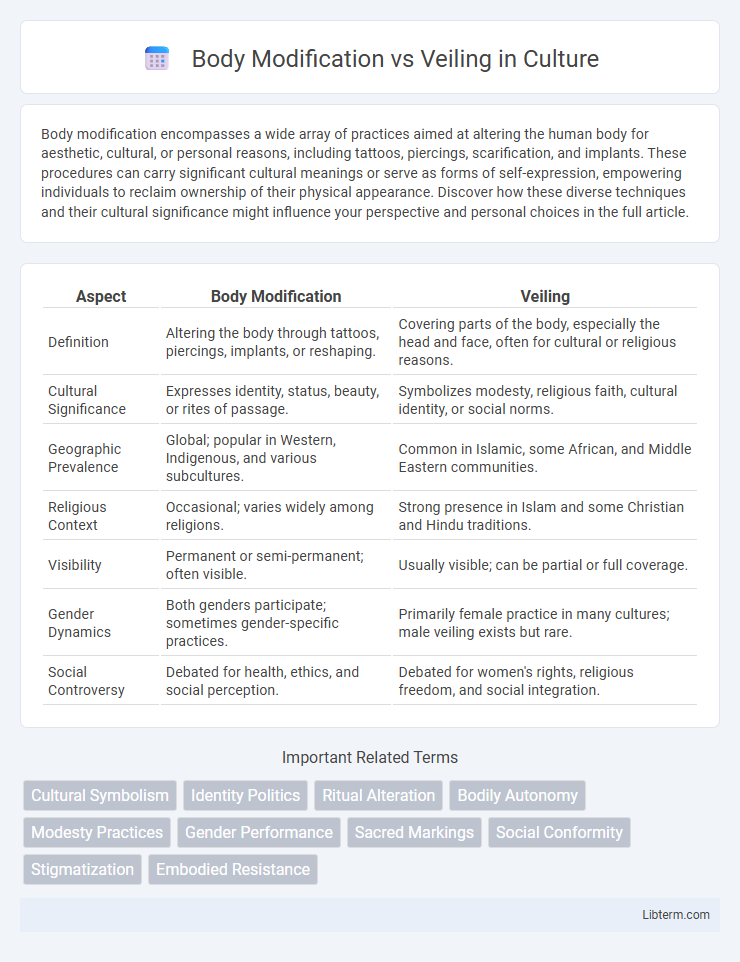Body modification encompasses a wide array of practices aimed at altering the human body for aesthetic, cultural, or personal reasons, including tattoos, piercings, scarification, and implants. These procedures can carry significant cultural meanings or serve as forms of self-expression, empowering individuals to reclaim ownership of their physical appearance. Discover how these diverse techniques and their cultural significance might influence your perspective and personal choices in the full article.
Table of Comparison
| Aspect | Body Modification | Veiling |
|---|---|---|
| Definition | Altering the body through tattoos, piercings, implants, or reshaping. | Covering parts of the body, especially the head and face, often for cultural or religious reasons. |
| Cultural Significance | Expresses identity, status, beauty, or rites of passage. | Symbolizes modesty, religious faith, cultural identity, or social norms. |
| Geographic Prevalence | Global; popular in Western, Indigenous, and various subcultures. | Common in Islamic, some African, and Middle Eastern communities. |
| Religious Context | Occasional; varies widely among religions. | Strong presence in Islam and some Christian and Hindu traditions. |
| Visibility | Permanent or semi-permanent; often visible. | Usually visible; can be partial or full coverage. |
| Gender Dynamics | Both genders participate; sometimes gender-specific practices. | Primarily female practice in many cultures; male veiling exists but rare. |
| Social Controversy | Debated for health, ethics, and social perception. | Debated for women's rights, religious freedom, and social integration. |
Understanding Body Modification: Definitions and Practices
Body modification encompasses a wide range of practices where individuals intentionally alter their physical appearance through methods such as tattooing, piercing, scarification, and implants. These modifications serve various cultural, aesthetic, and personal identity purposes, often reflecting deep symbolic meanings or individual expression. Understanding body modification requires recognizing its diverse forms across societies, distinct from veiling, which primarily involves covering the body or face for cultural, religious, or social reasons.
The History and Significance of Veiling
Veiling has a rich historical significance rooted in various religious, cultural, and social traditions across civilizations from ancient Mesopotamia to contemporary societies. It symbolizes modesty, identity, and social status, often representing spiritual beliefs and communal values intertwined with gender roles and societal norms. Unlike body modification, which primarily focuses on altering physical appearance for personal or aesthetic reasons, veiling emphasizes collective identity and moral conduct through clothing.
Cultural Motivations Behind Body Modification
Cultural motivations behind body modification often stem from traditions, rites of passage, and expressions of identity within specific communities. Practices such as tattooing, piercing, and scarification carry deep symbolic meanings related to spirituality, social status, or group affiliation. These modifications serve as physical manifestations of cultural heritage and personal narratives, contrasting with veiling, which is predominantly tied to religious beliefs and social norms centered on modesty.
Religious and Social Contexts of Veiling
Veiling in various religious traditions, such as Islam, Christianity, and Judaism, symbolizes modesty, spirituality, and identity, deeply rooted in scriptural and cultural mandates. Unlike body modification, which often centers on personal expression and aesthetic transformation, veiling reinforces communal values and social cohesion within conservative or devout societies. The practice serves as both a marker of religious observance and a visible assertion of social belonging, influencing gender dynamics and cultural perceptions of morality.
Autonomy and Personal Expression: Body Modification Perspectives
Body modification exemplifies individual autonomy through deliberate alterations like tattoos, piercings, and implants, reflecting personal identity and cultural significance. This form of self-expression allows individuals to assert control over their bodies, challenging societal norms and celebrating uniqueness. Embracing body modification empowers personal narratives, reinforcing bodily autonomy as a fundamental aspect of human rights and self-determination.
Veiling as Identity: Tradition or Choice?
Veiling serves as a powerful symbol of identity, rooted in cultural and religious traditions while also representing a conscious personal choice for many women. Its significance varies from an expression of faith and community belonging to an assertion of autonomy and empowerment. Unlike body modification, which often emphasizes physical alteration, veiling intertwines deeply with social, spiritual, and individual dimensions of identity.
Public Perception and Media Representation
Body modification often faces mixed public perception, ranging from appreciation for self-expression to stigmatization as deviant behavior, heavily influenced by media portrayal emphasizing extreme or sensational cases. Veiling, predominantly associated with cultural or religious identity, frequently encounters polarized media representation that either highlights personal empowerment or frames it as oppression, impacting public attitudes accordingly. Media narratives play a critical role in shaping societal understanding, frequently reinforcing stereotypes that affect both body modification and veiling communities.
Legal and Ethical Dimensions
Body modification practices such as tattoos and piercings face diverse legal regulations globally, often reflecting cultural norms and personal autonomy rights, while veiling laws are frequently entwined with state policies on religious expression and gender equality. Ethical debates on body modification emphasize individual consent and bodily autonomy, contrasting with veiling controversies where issues of oppression, freedom of religion, and social integration dominate. Legal frameworks must balance protecting human rights with respecting cultural diversity, addressing challenges posed by both body modification and veiling in contemporary societies.
Health Impacts and Safety Concerns
Body modification procedures such as tattoos and piercings carry risks including infections, allergic reactions, and scarring if not performed under sterile conditions by trained professionals. Veiling, often associated with cultural or religious practices, generally poses minimal direct health risks but may affect respiratory health or skin conditions due to limited ventilation and exposure to sunlight. Ensuring proper hygiene and awareness of individual health conditions is crucial in minimizing adverse effects for both body modification and veiling practices.
Intersectionality: Gender, Power, and Cultural Narratives
Body modification and veiling both serve as powerful expressions of identity influenced by the intersections of gender, power, and cultural narratives. These practices reveal how societal norms shape personal autonomy, where body modification often challenges traditional gender roles while veiling may signify cultural or religious adherence intertwined with patriarchal control. Understanding their complexities requires analyzing how gendered power dynamics and cultural storytelling negotiate freedom and conformity in diverse communities.
Body Modification Infographic

 libterm.com
libterm.com